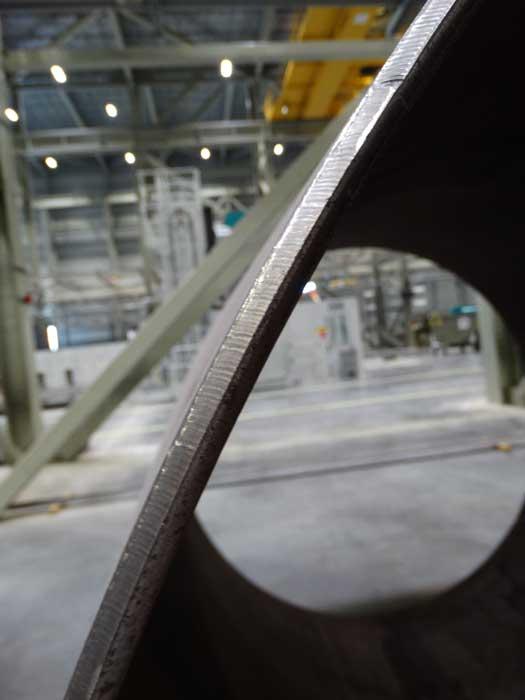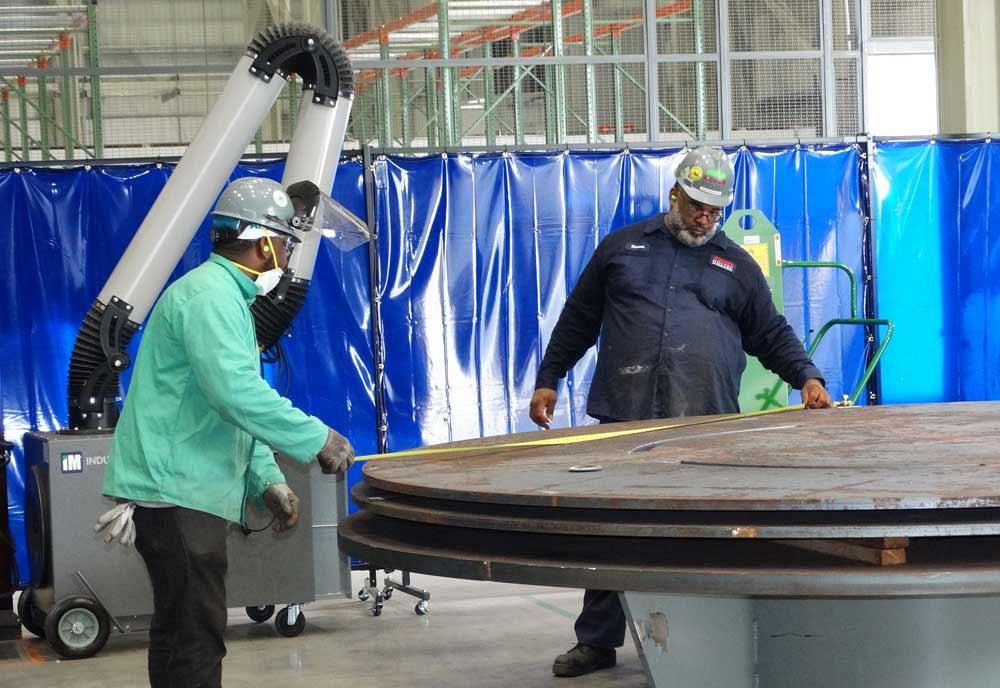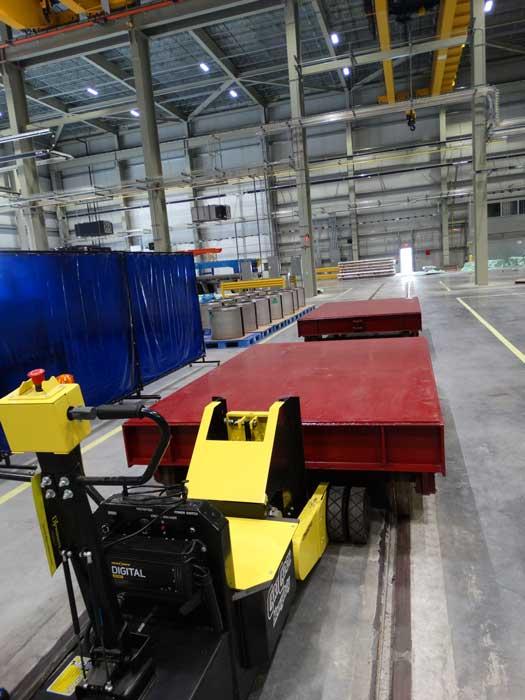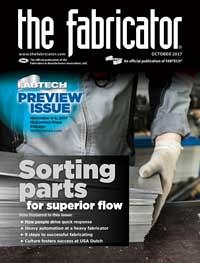Senior Editor
- FMA
- The Fabricator
- FABTECH
- Canadian Metalworking
Categories
- Additive Manufacturing
- Aluminum Welding
- Arc Welding
- Assembly and Joining
- Automation and Robotics
- Bending and Forming
- Consumables
- Cutting and Weld Prep
- Electric Vehicles
- En Español
- Finishing
- Hydroforming
- Laser Cutting
- Laser Welding
- Machining
- Manufacturing Software
- Materials Handling
- Metals/Materials
- Oxyfuel Cutting
- Plasma Cutting
- Power Tools
- Punching and Other Holemaking
- Roll Forming
- Safety
- Sawing
- Shearing
- Shop Management
- Testing and Measuring
- Tube and Pipe Fabrication
- Tube and Pipe Production
- Waterjet Cutting
Industry Directory
Webcasts
Podcasts
FAB 40
Advertise
Subscribe
Account Login
Search
Plate rolling, cutting, welding, and thinking big
Nuclear industry fabricator builds capacity, focuses on flow
- By Tim Heston
- October 16, 2017
- Article
- Bending and Forming

A carbon steel rolled cylinder sits complete. Behind it is a massive boring and milling center, able to complete multiple operations in one setup.
Look up when stepping into Holtec International’s new manufacturing plant near the banks of the Delaware River in South Camden, N.J., and you’ll see 12 overhead cranes—nine 50-ton and three 200-ton—that move over 370,000 square feet, divided into five manufacturing bays.
“That gives you a sense of the size and scope of this place.”
So said Procurement Manager Greg McGann, who began his factory tour by touting those crane capacity numbers. That wouldn’t surprise anyone who has worked in a busy heavy fabrication plant, where people sometimes spend too much of their day waiting for cranes. What should surprise them is that although Holtec has a lot of crane capacity, it doesn’t use them to capacity, at least not yet.
To find out why, just look at the 20-ft.-wide Davi plate roll in Bay 1. It isn’t a stand-alone system but instead integrated with conveyors and other mechanized material handling. Submerged arc welding (SAW), grinding, and rolling occur in one automated unit, no crane moves required.
“Two factors [when designing this plant] were minimizing material movement and automation,” said Lee Laurendeau, director of manufacturing. “We developed a process map and then scrutinized it. If it was non-value-added, we got rid of it. If it was manual, we considered automating it.”
He added one more factor: capacity for the future, as exemplified by a massive variable-geometry plate roll at the riverside end of Bay 3. With a 57-in.-diameter top roll, the monster of a machine was purchased to roll extremely thick plate. One product it will form will be the Small Modular Reactor, or SMR-160, which will call for the rolling of 110-KSI-tensile-strength, 5-in.-thick material. It will debut in several years, and when it does, it will represent a new approach to nuclear power generation.
According to a company press release, “SMR-160 is a passive, intrinsically safe, supremely secure, and economically attractive small modular reactor with the flexibility to be used in remote locations, in areas with limited water supplies or land, and in unique industrial applications where traditional large reactors are not practical.”
The spirit behind the SMR—a big, radical departure in the nuclear power field—can be felt the moment you drive to the Holtec Technology Center campus: the plant, the office building adjacent to it, and the unobscured riverfront view of the Walt Whitman Bridge and downtown Philadelphia. The people there follow the company founder’s approach to business. They don’t do half measures. They go all out and think big.
A Little History
Holtec’s story starts with Dr. Krishna Singh, who launched the company in 1986. The company’s product lines began in the industrial space, with heat exchangers, water treatment tanks, and similar products. Over the years they evolved to include critical fabrications for the nuclear industry, especially those able to store and transport spent nuclear fuel. The walls near the foyer of Holtec’s office building are covered with patents.
For years the company outsourced much of its fabrication, but this changed in 2005 when it purchased one of its major suppliers, U.S. Tool and Die, in Turtle Creek, Pa., east of Pittsburgh.
Over the years the plant expanded like many industrial fabricators have done. The company outgrew one facility and purchased another, then a third, and finally a fourth. Managers put new machines where they could fit them. Manufacturing steps were broken up into process villages, with plate rolling in one building, welding and grinding in another.
When analyzing one of Holtec’s major product lines, the Multi-Purpose Canister, or MPC, the improvement team found that workers needed to perform more than 40 crane moves.
In recent years the Turtle Creek plant has invested in certain material handling systems, including upenders to manipulate MPCs and other rolled workpieces without a crane. Still, managers had to deal with limitations, including the fact that fabrication and assembly occurred over four separate facilities.
By 2010 the SMR project was underway, and company executives soon realized they would face unique manufacturing challenges. These included the requirement to roll 5-in.-thick, 110-KSI-tensile-strength plate. They also considered potential growth and Holtec’s approach to fabrication overall. Ultimately, they decided a new, purpose-built facility was the way to go.
Pilings, Pilings Everywhere
In 2014 Holtec announced its plans to build a new campus along the Delaware, including a new plant with no walls between bays, plenty of crane capacity, and a major focus on product flow. It was designed to house a massive plate roll, 110-ft. blast booth next to an equally large paint booth (both large enough to accept the anticipated size of the SMR), as well as a towering vertical turning lathe (VTL) and versatile machining center.
Holtec chose land right by the river not just for the view, but for its transportation potential. Shipping products by barge directly from the campus likely won’t happen for several years, considering the dredging and other investments involved, but the company does have access to nearby port facilities along the river.
All the same, the location proved challenging, considering the shallow water table. “The water table is only 5 ft. below the floor,” Laurendeau said. “We had to do a lot of waterproofing.”
The land had a lot of debris underground, being the former site of the New York Naval Shipyard. Moreover, the building’s 4,500 piles (and no, that number is not a typo) had to be driven 90 ft. down below the river mud. “We have more than 50 miles of piles,” Laurendeau said.
A lot of the early planning involved foundations for the plant’s massive machines, including the large plate roll. As Alex Soffritti, president of Dallas-based Davi Inc., explained, “We were provided the specifications for the foundation a year and a half prior to installation. Because it’s so close to the water, the [large variable-geometry] plate roll needed a special foundation, including a double-wall protection to prevent flooding.”
Focus on Flow
Certain areas of the factory do resemble conventional industrial fabrication. For instance, in Bay 3, aside from the massive plate roll at one end, the space is dedicated mainly to code-level welding and general fabrication. Welding workstations line the bay, and everything is designed to be reconfigured as new projects come in the door
The layout looks distinctly different in the other bays. A VTL and a versatile boring and milling center, both several stories high, machine lids and other components in one setup, combining what was once multistep operations into one. And then there is the fabrication in Bay 1, where automation has made single-piece part flow a reality even for products as large as the MPC, which can be 16 ft. tall.
The process starts with a Tanaka 6-kW CO2 laser cutting machine, which can cut as well as bevel the 5/8-in.-thick stainless steel that makes the MPC’s inner shell. The plates then move to the 20-ft. plate roll integrated with the SAW system. Sources said they could not reveal details about this, but the setup does use specialized carriages and other material handling systems. Ultimately, the automation is a key component that dramatically reduces the number of crane moves required to fabricate the MPC.
Still, any production line is only as fast as its constraint process. Because these MPCs, along with all other products Holtec produces, are for the nuclear industry, inspection is critical. Because the inner stainless shell of the MPC comes in direct contact with spent nuclear fuel, all welds must undergo X-ray inspection.
This can be slow and arduous, with weld inspection technicians operating the radiography equipment and then penciling or keying in the data. If the company had automated fabrication and yet not done anything to speed inspection, dozens of cans would be sitting near quality control, awaiting inspection. Overall manufacturing time wouldn’t have changed, mitigating the entire reason for investing in automation in the first place.
But Holtec didn’t do this. Instead, it automated inspection. Every MPC shell rides on a carriage that transports it into a room. After the doors close automatically, an X-ray unit on a mechanical boom inspects the one circumferential and two longitudinal welds, and then transmits the data to software, no keying-in required.
Training
Facilities Manager Dan Miller, who spent most of the summer in Camden to help ramp up production, is based out of Turtle Creek, where he joined the company in 2006. Back then, along with the people it employed at its fabrication operations in Turtle Creek, Holtec had roughly 40 engineers and managers based in Marlton, N.J. This year everyone in Marlton, about 200 in all, moved to the new campus on the Delaware. This summer about 80 people worked in the Camden plant, and many more jobs are to come as the plant ramps up production this year and next.
“Our standard product line revolves around spent nuclear fuel,” Miller said. “We can’t flip a switch and make people competent in the nuclear safety culture. It takes time to develop that.”
Allen Hickman, vice president of manufacturing and supply chain, added, “Safety comes first, followed by quality, then productivity, and then the schedule.”
To that end, Holtec has invested heavily in training. This not only brings shop floor employees up to speed on manufacturing technology, but also cross-trains them as much as possible. Of course, no one is expected to perform tasks they’re not qualified to do. But even the most mundane tasks shouldn’t be beneath the most highly qualified person, if it’s done with improved flow in mind.
“The message here is, ‘You can do everything to help product flow,’” Laurendeau said. “We don’t want, ‘I only do this, and once this is finished, I’m done.’ That’s one of the reasons why products don’t flow.”

A carriage system (closeup on top) is designed to transport a rolled shell between the plate roll and an automated submerged arc welding and grinding system (out of frame).
Sources admitted that this mentality takes some getting used to, particularly for those in the nuclear fabrication arena. If someone is a highly experienced, ASME-code-certified welder, it would stand to reason that person would work on critical welds and nothing else. After all, that employee represents an extremely valuable resource, so why pay him to grind, move material, or sweep the floor? But as Laurendeau explained, if doing those tasks helps product flow, the worker is actually adding more value than he would by welding work that couldn’t flow downstream anyway.
Laurendeau referred to the automated rolling and welding cell for the MPC. “Our rolling operator is also a welder,” he said. “He is able to follow the job through multiple steps.”
Three Things
Holtec’s strategy along the Delaware River boils down to three things: people, fabrication capabilities, and productivity. People are offered training and work in a safe, well-lit environment, with natural light showing through the ceiling.
They’re also given the fabrication capabilities, including some eye-opening rolling capacity, both in terms of speed (as seen in the MPC line) and thickness, with the large variable-geometry plate roll. The top roll is so heavy, at more than 150,000 lbs., that during installation a special crane had to be brought in to lift and place the massive roll on the machine frame.
Although the machine was purchased to roll 5-in.-thick high-strength material for the SMR, it can roll thicker in 60-KSI carbon steel—up to 9.5 in. cold at 8 ft. wide. Holtec has no ovens for hot rolling yet, but it ordered its plate roll to be able to handle hot plate, should the plant buy a furnace and delve into hot rolling down the road. This meant that the rolls had to be designed to be hard enough to roll 110-KSI stock, but tough and ductile enough to handle hot plate.
Last year Davi ran a test piece of 110-KSI-tensile, 5-in.-thick material—and the cost of that test piece showed why productivity is so important at a fabricator like Holtec.
Recalled Matteo Rossi, Davi area manager, “The cost of that plate, just a raw test plate, was $45,000.”
The operator must be careful to avoid overbending such expensive plate. Overbend it and it’s probably beyond repair. All the same, having such a workpiece just sit on the floor, waiting for a crane, can be a cash flow killer. It’s like having a mound of $45,000 on the floor and doing nothing with it.
Sources conceded that fabrication in the nuclear industry does take time. Product development takes years. The SMR has been in the works since 2010 and is still not expected for another several years. Moreover, training and recordkeeping are critical. Every step needs to follow specific signoff procedures to ensure perfect quality.
But perfect quality doesn’t mean that workers need to spend their days waiting for cranes, or rolling and welding products that downstream processes won’t be able to handle anyway—especially if they’re given the tools and equipment to ensure products keep flowing.

Workers at a grinding station measure an end cap. A local fume capture system sits in the background.
In heavy fabrication in the nuclear industry, this has meant taking an unusual approach. Just because a product is massive doesn’t mean it can’t be moved efficiently.
As Miller recalled, “The No. 1 mandate we had when we were told to build this place was, ‘Build a factory with unique capabilities,’ and we’ve certainly done that.”
Holtec International, 856-797-0900, www.holtecinternational.com
About the Author

Tim Heston
2135 Point Blvd
Elgin, IL 60123
815-381-1314
Tim Heston, The Fabricator's senior editor, has covered the metal fabrication industry since 1998, starting his career at the American Welding Society's Welding Journal. Since then he has covered the full range of metal fabrication processes, from stamping, bending, and cutting to grinding and polishing. He joined The Fabricator's staff in October 2007.
Related Companies
subscribe now

The Fabricator is North America's leading magazine for the metal forming and fabricating industry. The magazine delivers the news, technical articles, and case histories that enable fabricators to do their jobs more efficiently. The Fabricator has served the industry since 1970.
start your free subscription- Stay connected from anywhere

Easily access valuable industry resources now with full access to the digital edition of The Fabricator.

Easily access valuable industry resources now with full access to the digital edition of The Welder.

Easily access valuable industry resources now with full access to the digital edition of The Tube and Pipe Journal.
- Podcasting
- Podcast:
- The Fabricator Podcast
- Published:
- 04/16/2024
- Running Time:
- 63:29
In this episode of The Fabricator Podcast, Caleb Chamberlain, co-founder and CEO of OSH Cut, discusses his company’s...
- Trending Articles
How to set a press brake backgauge manually

Capturing, recording equipment inspection data for FMEA

Tips for creating sheet metal tubes with perforations

Are two heads better than one in fiber laser cutting?

Hypertherm Associates implements Rapyuta Robotics AMRs in warehouse

- Industry Events
16th Annual Safety Conference
- April 30 - May 1, 2024
- Elgin,
Pipe and Tube Conference
- May 21 - 22, 2024
- Omaha, NE
World-Class Roll Forming Workshop
- June 5 - 6, 2024
- Louisville, KY
Advanced Laser Application Workshop
- June 25 - 27, 2024
- Novi, MI





























